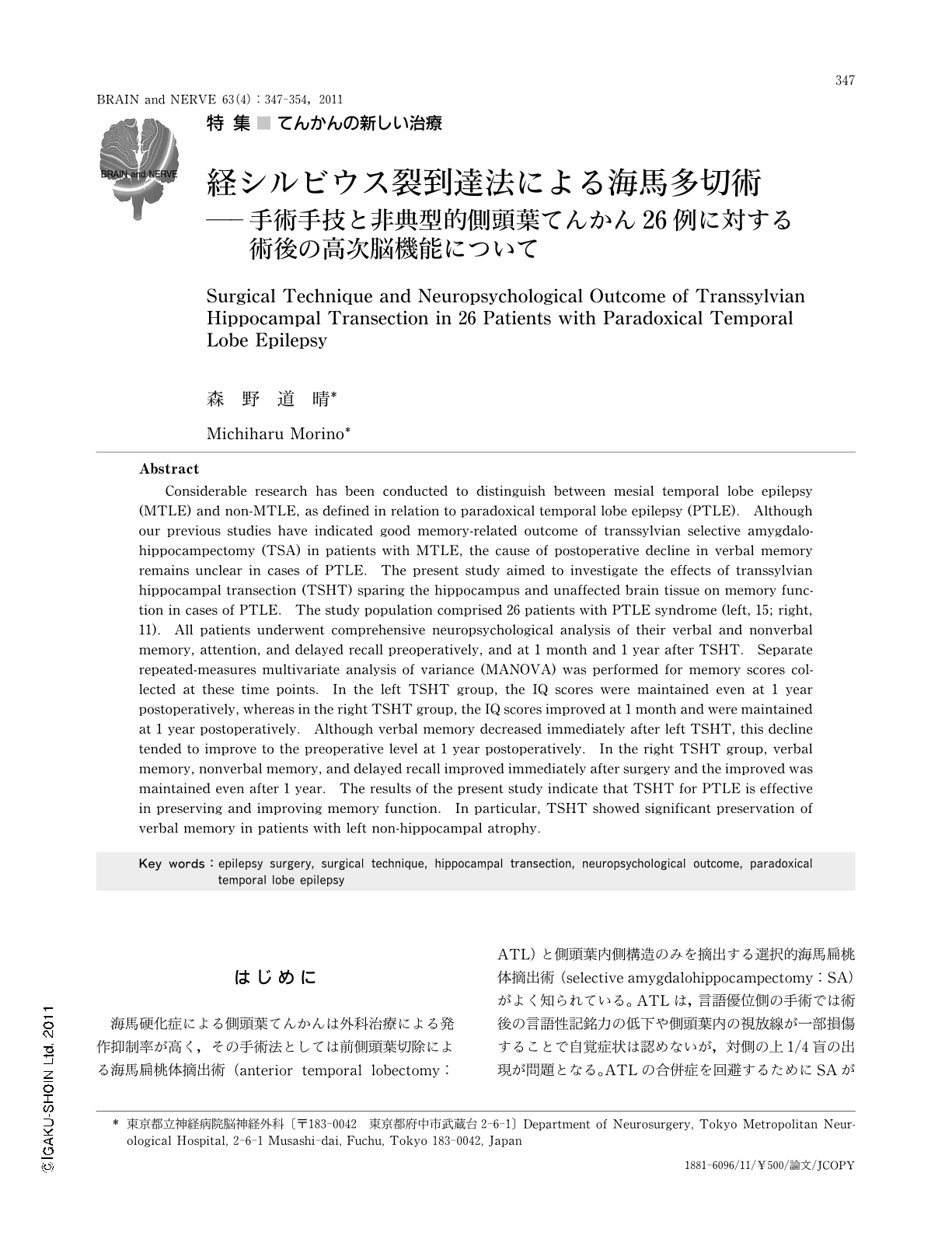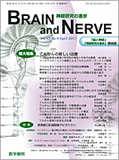Japanese
English
- 有料閲覧
- Abstract 文献概要
- 1ページ目 Look Inside
- 参考文献 Reference
はじめに
海馬硬化症による側頭葉てんかんは外科治療による発作抑制率が高く,その手術法としては前側頭葉切除による海馬扁桃体摘出術(anterior temporal lobectomy:ATL)と側頭葉内側構造のみを摘出する選択的海馬扁桃体摘出術(selective amygdalohippocampectomy:SA)がよく知られている。ATLは,言語優位側の手術では術後の言語性記銘力の低下や側頭葉内の視放線が一部損傷することで自覚症状は認めないが,対側の上1/4盲の出現が問題となる。ATLの合併症を回避するためにSAが開発されたが,記憶中枢である海馬を切除するため両手術法ともに術後の記銘力低下が問題となる。ATLに比してSAでの記銘力予後は優れているという報告1-3)が多いが,SAを行っても術後の記銘力,特に左側手術後の言語性記銘力が低下するという報告1,4-6)と低下しないという報告7-10)がみられる。ただ一般に,海馬硬化症では患者の記銘力が低下している例が多いため,それほど大きな問題にはされていない。しかし海馬硬化症ではない,つまり画像で海馬萎縮が認められないいわゆる非典型的側頭葉てんかん(paradoxical temporal lobe epilepsy:PTLE)11)は術前の記銘力が正常であることが多いため,海馬切除後に記銘力低下が顕著となる可能性が高い。このPTLEや腫瘍が側頭葉に存在し,海馬が2次性にてんかん原性を獲得した例に対して言語性記銘力を温存しながら発作抑制を行える治療法が望まれていた。Shimizuらは2006年に,左PTLEの言語性記銘力温存に自身が開発した経上側頭回到達法による海馬多切術が有効であることを発表した12)。筆者は以前より,内側側頭葉てんかんに対して経シルビウス裂到達法によるSAを行い,記銘力温存あるいは改善に有効であることを報告した9,10)。このため海馬多切術を経シルビウス裂到達法で行うことにより,側頭葉外側皮質の損傷による記銘力予後への悪影響を最小限にするように心がけている。そこで本稿では,代表例の術中写真を提示しながら,経シルビウス裂到達法による海馬多切術(transsylvian hippocompal transection:TSHT)の手術法とPTLE26例の発作予後および術前後の脳高次機能を含む手術治療成績について述べる。
Abstract
Considerable research has been conducted to distinguish between mesial temporal lobe epilepsy (MTLE) and non-MTLE,as defined in relation to paradoxical temporal lobe epilepsy (PTLE). Although our previous studies have indicated good memory-related outcome of transsylvian selective amygdalohippocampectomy (TSA) in patients with MTLE,the cause of postoperative decline in verbal memory remains unclear in cases of PTLE. The present study aimed to investigate the effects of transsylvian hippocampal transection (TSHT) sparing the hippocampus and unaffected brain tissue on memory function in cases of PTLE. The study population comprised 26 patients with PTLE syndrome (left,15; right,11). All patients underwent comprehensive neuropsychological analysis of their verbal and nonverbal memory,attention,and delayed recall preoperatively,and at 1 month and 1 year after TSHT. Separate repeated-measures multivariate analysis of variance (MANOVA) was performed for memory scores collected at these time points. In the left TSHT group,the IQ scores were maintained even at 1 year postoperatively,whereas in the right TSHT group,the IQ scores improved at 1 month and were maintained at 1 year postoperatively. Although verbal memory decreased immediately after left TSHT,this decline tended to improve to the preoperative level at 1 year postoperatively. In the right TSHT group,verbal memory,nonverbal memory,and delayed recall improved immediately after surgery and the improved was maintained even after 1 year. The results of the present study indicate that TSHT for PTLE is effective in preserving and improving memory function. In particular,TSHT showed significant preservation of verbal memory in patients with left non-hippocampal atrophy.

Copyright © 2011, Igaku-Shoin Ltd. All rights reserved.


